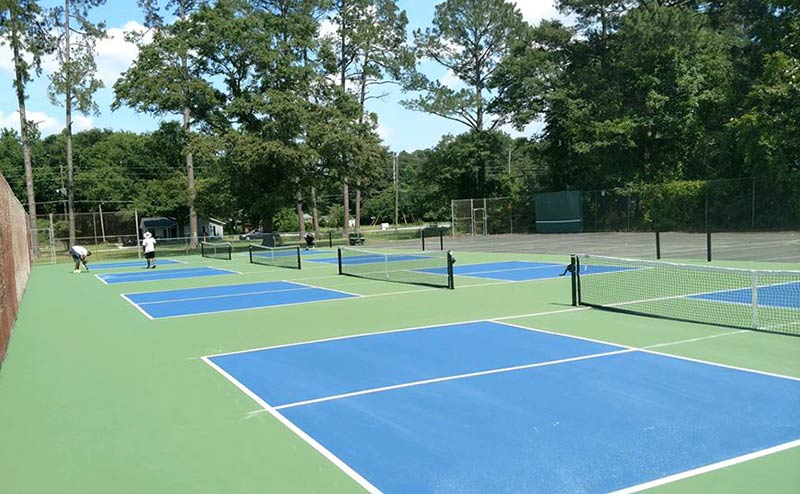Elevate Your Sports Center with an Expert Pickleball Court Construction Company
Elevate Your Sports Center with an Expert Pickleball Court Construction Company
Blog Article
Enhance Your Area With Expert Pickleball Court Construction
The building and construction of professional pickleball courts offers an one-of-a-kind chance for communities to foster social interaction and advertise healthy and balanced lifestyles. Pickleball court construction company. By thoughtfully taking into consideration layout elements and community requirements, stakeholders can produce courts that reverberate with homeowners.
Benefits of Pickleball Courts
The building of devoted pickleball courts provides numerous benefits that expand beyond mere recreational possibilities. One of the most substantial advantages is the promotion of community involvement and social communication.
Furthermore, devoted pickleball courts can contribute to boosted physical health and wellness within the neighborhood. As the sport is accessible and reasonably simple to discover, it attracts people that may not otherwise involve in routine workout. The combination of cardio activity and control called for in pickleball aids improve cardio health and wellness, flexibility, and total physical fitness.
Moreover, the facility of pickleball courts can increase building values in the surrounding location. Possible homebuyers often seek neighborhoods with leisure amenities, and devoted sports facilities can enhance the allure of a community.
Key Layout Considerations

Surface area material considerably influences gameplay and gamer convenience. Options such as asphalt, concrete, or specialized sports surfaces can influence round bounce and player agility. Additionally, correct surface drain will decrease water accumulation, making certain the courts stay usable in numerous weather condition conditions.
Illumination is one more essential element, particularly for evening play. Adequate illumination ought to be evenly distributed to remove shadows and improve visibility. Additionally, factor to consider ought to be provided to the positioning of the courts to decrease sunlight glare throughout peak hours.
Lastly, availability and community assimilation are necessary. Courts must be simple to accessibility for all gamers, including those with disabilities, and need to be created to mix perfectly right into existing community areas, fostering a welcoming ambience for social interaction and entertainment use.
Steps in Court Construction
Successful construction of pickleball courts entails a collection of well-defined steps to ensure high quality and conformity with well established requirements. Pickleball court construction company. The process begins with comprehensive website evaluation, evaluating elements such as dirt drainage, room, and security availability. A precise survey is critical to figure out the optimum format and positioning of the courts
Following, extensive preparation and style take area, including the choice of products and surface area types that satisfy the main specs for pickleball play. Adhering to authorization of the layouts, excavation and grading commence. This step guarantees a level structure, which is vital for court performance.
Once the base is prepared, the installation of ideal water drainage systems is performed, stopping water build-up and potential damage. Later, the selected surface material, whether asphalt or concrete, is laid and ended up to develop the desired texture and finish.
Area Engagement Techniques
Effective community interaction methods are vital for garnering support and promoting excitement for pickleball court building and construction projects. Involving the area from the beginning helps to make certain that the demands and needs of local homeowners are incorporated right into the design and implementation phases.

Cooperation with neighborhood organizations, such as institutions, parks and leisure departments, and pickleball clubs, can official website intensify outreach efforts. These collaborations can facilitate workshops and presentation occasions that not only enlighten homeowners yet likewise generate excitement about the upcoming facilities.
Furthermore, leveraging social networks platforms can create a continuous discussion, permitting updates and encouraging ongoing involvement. By actively involving the area in the planning process, job leaders can grow a feeling of ownership, making sure that the pickleball courts come to be a vibrant center for physical task and social interaction. Involving the neighborhood efficiently prepares for a successful and well-supported building and construction task.
Success Stories and Instances

Another success tale comes from a large urban facility that partnered with regional organizations to produce a vibrant pickleball center within a public park. The partnership resulted Go Here in an advanced facility that hosts leagues and events, promoting social communication and financial growth for close-by establishments.
In both instances, neighborhood participants were associated with the decision-making process, ensuring the courts satisfied their preferences and demands. These examples underscore the value of cooperation in between city governments, businesses, and homeowners in developing rooms that enhance community well-being. With shared resources and goals, towns can change uninhabited lots or underutilized locations right into dynamic pickleball courts that offer as a centerpiece for engagement and activity.
Verdict
In conclusion, the building and construction of professional pickleball courts provides significant advantages to neighborhoods, consisting of boosted social communication, improved physical health, and increased building worths. By adhering to key style considerations and engaging neighborhood stakeholders throughout the planning process, neighborhoods can produce centers that deal with their one-of-a-kind demands. Successful application of these courts can bring about vivid leisure rooms that promote neighborhood bonds and add to a healthier, a lot more active lifestyle for all homeowners.
The construction of specialist pickleball courts provides a distinct possibility for areas to foster social interaction and promote healthy and balanced lifestyles. The measurements of the court are essential; a conventional pickleball court determines 20 feet wide by 44 feet long for both singles and doubles play. By proactively involving the neighborhood in the planning process, job leaders can grow a sense of ownership, ensuring that the pickleball courts become a vivid center for physical activity and social interaction.Highlighting successful pickleball court construction projects provides beneficial insights right into the advantages of neighborhood involvement and helpful resources collaboration.In conclusion, the building of specialist pickleball courts offers significant benefits to communities, including enhanced social interaction, improved physical health and wellness, and increased property values.
Report this page